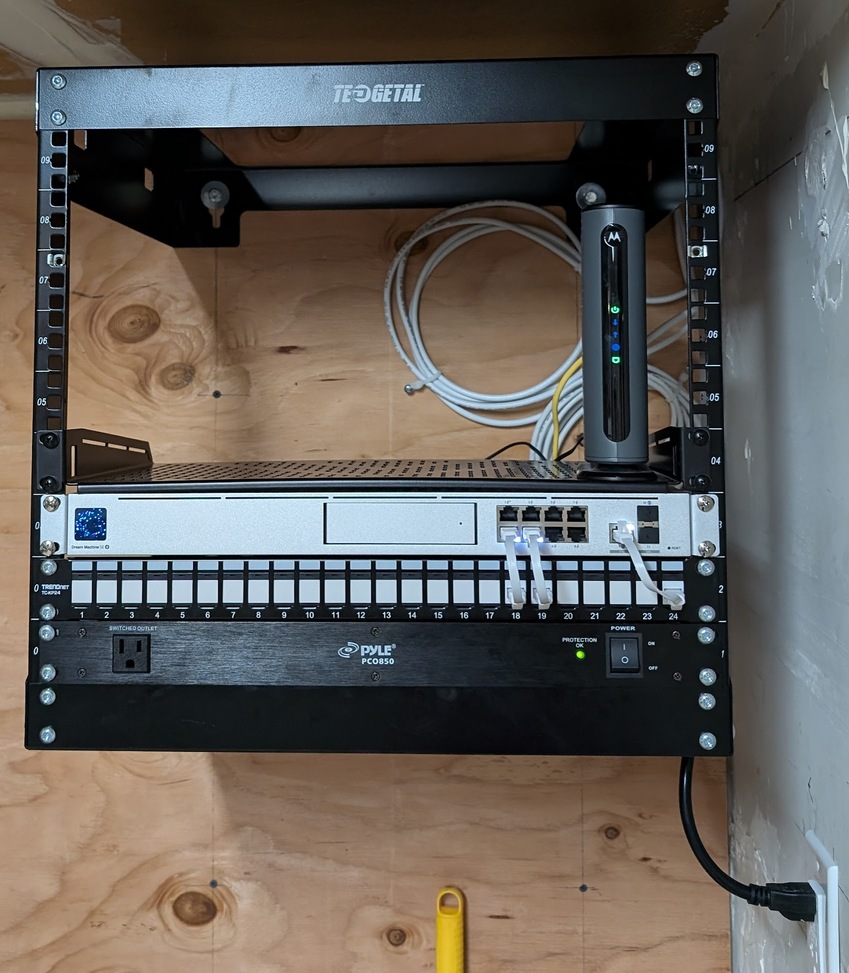NixOS, Raspberry Pi & Me
Published 2024-08-13 on Farid Zakaria's Blog
I have written a lot about NixOS, so it’s no surprise that when I went to go dust off my old Raspberry Pi 4, I looked to rebrand it as a new NixOS machine.
Before I event went to play with my Pi, I was unhappy with my current home-networking setup and looked to give it a refresh.
I have had always a positive experience with Ubiquiti line of products. I installed two new AP (access points) and setup a beautiful home rack server that is completely unnecessary since my Internet provider is Comcast with top upload speeds of 35 Mbps 🥲.
I’m currently building a home-server that will fill a few of the empty slots on the rack.
If you are interested in the setup here is the list of materials I used:
- Dream Machine Special Edition
- U6 Access Point
- 9U Wall Mount Rack
- 1U Universal Rack Shelf
- Cat6 Keystone Coupler 5-Pack
- Blank Keystone Jack Inserts
- Cat6 Ethernet Cable 0.5ft 5 Pack
- 24-Port Blank Keystone 1U Patch Panel
- 1U PDU Power Strip Surge Protector
Now, getting back to the Raspberry Pi, there’s quite a few blogs online on how to run NixOS but they all vary slightly in their setup and few are set up to use flake.nix.
Now I’m throwing mine to the mix 🥳.
You can find below my minimal configuration.nix for my Raspberry Pi (the link goes to GitHub permalink).
Notable points I had to do:
- Feedback from the community on Matrix was to avoid nixos-hardware since the base image should just work.
Unfortunately
nixos-hardware.nixosModules.raspberry-pi-4was necessary, as was the vendored Linux kernel it installs. - Cross compiling NixOS I believe is possible but I couldn’t find a simple set up with flake.nix to work. The ultimate workaround is to add
support for emulation on your build host. This also does let you use the NixOS cache but be warned that if you install custom software might come to a crawl.
binfmt.emulatedSystems = ["aarch64-linux"]; - I disabled ZFS to save a lot of time building my image.
compressImageis disabled since it takes a long time with emulation.makeModulesClosuresnippet below is needed since some Linux kernel modules fail to compile. 🤷
Final thoughts 🤔
While it’s cathartic to have your Pi running NixOS and “declarative”, the whole experience left much to be desired. While cross-compiling feels tenable at the individual package level, it was confusing and challenging to setup (I gave up!) to build a complete image.
Given the popularity of Raspberry Pi and the Internet of things, there is a strong opportunity to bring a simple setup for Pi’s into mainline Nixpkgs with clear support and guidance on how to cross-compile the image.
❗ If you think my configuration.nix could be improved or you have the solution to cross-compiling, let me know!
configuration.nix
Having a starting NixOS configuration means you can avoid the base installer and directly create the initial image via
❯ nix build '.#nixosConfigurations.kuato.config.system.build.sdImage'
Subsequent updates can happen via ssh. I build the image on my x86_64 machine via emulation using
the following command which then copies the /nix/store closure and activates the new generation.
❯ nixos-rebuild switch --flake .#kuato \
--target-host fmzakari@kuato \
--use-remote-sudo
{
config,
pkgs,
inputs,
outputs,
lib,
modulesPath,
...
}: {
imports = [
# had a big discussion on Matrix on which to use for the Raspberry Pi 4
# looks like there are pi specific modules but they told me to not use them.
# Also don't use the vendored Linux kernel and just use the regular one.
"${modulesPath}/installer/sd-card/sd-image-aarch64.nix"
../../modules/nix.nix
# Feedback from Matrix was to disable this and it's unnecessary unless you are using
# some esoteric hardware.
inputs.nixos-hardware.nixosModules.raspberry-pi-4
];
# let's not build ZFS for the Raspberry Pi 4
boot.supportedFilesystems.zfs = lib.mkForce false;
# compressing image when using binfmt is very time consuming
# disable it. Not sure why we want to compress anyways?
sdImage.compressImage = false;
# enable the touch screen
hardware.raspberry-pi."4".touch-ft5406.enable = true;
# we don't import ../../modules/nixpkgs.nix since we don't want the overlay
# rebuilding for the Raspberry Pi 4 is expensive; try to stick to what is in the cache.
nixpkgs = {
hostPlatform = lib.mkDefault "aarch64-linux";
config = {
allowUnfree = true;
};
overlays = [
# Workaround: https://github.com/NixOS/nixpkgs/issues/154163
# modprobe: FATAL: Module sun4i-drm not found in directory
(final: super: {
makeModulesClosure = x:
super.makeModulesClosure (x // {allowMissing = true;});
})
];
};
fileSystems = {
"/" = {
device = "/dev/disk/by-label/NIXOS_SD";
fsType = "ext4";
options = ["noatime"];
};
};
networking = {
networkmanager.enable = true;
hostName = "kuato";
};
# Set your time zone.
time.timeZone = "America/Los_Angeles";
environment.systemPackages = with pkgs; [
libraspberrypi
raspberrypi-eeprom
];
services = {
# Enable the X11 windowing system.
xserver = {
enable = true;
desktopManager = {
gnome.enable = true;
};
displayManager = {
# Enable the GNOME Desktop Environment
gdm = {
enable = true;
# FIXME: I want to disable wayland but the touch screen seems
# to not work otherwise.
# wayland = false;
};
};
};
};
# Normally we would re-use the same user configurations in the users directory
# but since this is a Raspberry Pi 4, lets make a much smaller closure.
users.users.fmzakari = {
isNormalUser = true;
shell = pkgs.bash;
extraGroups = ["wheel" "networkmanager"];
description = "Farid Zakaria";
openssh.authorizedKeys.keyFiles = [
../../users/fmzakari/keys
];
# Allow the graphical user to login without password
initialHashedPassword = "";
};
# simplify sudo
security = {
sudo = {
enable = true;
wheelNeedsPassword = false;
};
};
# Allow the user to log in as root without a password.
users.users.root.initialHashedPassword = "";
hardware.enableRedistributableFirmware = true;
system.stateVersion = "23.11";
}
Improve this page @ 89107ef
The content for this site is
CC-BY-SA.
